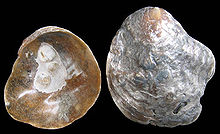| Anomia | |
|---|---|

| |
| Two upper valves of A. ephippium | |
| Scientific classification | |
| Domain: | Eukaryota |
| Kingdom: | Animalia |
| Phylum: | Mollusca |
| Class: | Bivalvia |
| Order: | Pectinida |
| Family: | Anomiidae |
| Genus: | Anomia Linnaeus, 1758 |
| Species | |
| |
| Synonyms | |
| |
Anomia is a genus of saltwater clams, marine bivalve mollusks in the family Anomiidae. They are commonly known as jingle shells because when a handful of them are shaken they make a jingling sound,[2] though some are also known as saddle oysters.[3]
This genus first appeared in the Permian period of China, Italy, and Pakistan.[4] Anomia species are common in both tropical and temperate oceans and live primarily attached to rock or other shells via a calcified byssus that extends through the lower valve.[1] Anomia shells tend to take on the surface shape of what they are attached to; thus if an Anomia is attached to a scallop shell, the shell of the Anomia will also show ribbing.[1] The species A. colombiana has been found in the La Frontera Formation of Boyacá, Cundinamarca and Huila of Colombia.[5]
- ^ a b c Ludvigsen, Rolf & Beard, Graham. 1997. West Coast Fossils: A Guide to the Ancient Life of Vancouver Island. pg. 109
- ^ Gofas, S. (2010) Anomia Linnaeus, 1758. In: Bouchet, P.; Gofas, S.; Rosenberg, G. (2010) World Marine Mollusca database. Accessed through: World Register of Marine Species at http://www.marinespecies.eu/aphia.php?p=taxdetails&id=137650 Archived 2016-03-04 at the Wayback Machine on 2010-06-06
- ^ "Saddle oyster - Anomia ephippium". The Marine Life Information Network.
- ^ Paleobiology database entry on Anomia
- ^ Patarroyo, Pedro (2016). "Amonoideos y otros macrofósiles del lectoestratotipo de la Formación la Frontera, Turoniano inferior - medio (Cretácico Superior) en San Francisco, Cundinamarca (Colombia)" (PDF). Boletín de Geología, Universidad Industrial de Santander. 38: 41. Retrieved 2017-04-04.